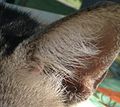Cat anatomy
Overview of the anatomy of cats
Cat anatomy refers to the physical structure and internal workings of the domestic cat, a small, carnivorous mammal that is a popular pet worldwide. Understanding cat anatomy is crucial for veterinarians, pet owners, and anyone interested in feline biology.
Skeletal System[edit]
The skeleton of a cat is composed of approximately 230 to 250 bones, depending on the length of the tail and the number of toes. Cats have a flexible spine and a unique collarbone (clavicle) that allows them to pass through any space into which they can fit their head.
Skull[edit]
The skull of a cat is short and rounded, with large eye sockets and a powerful jaw. The teeth are adapted for killing prey and tearing meat. Cats have 30 permanent teeth, including sharp canines and specialized carnassial teeth for shearing flesh.
Vertebral Column[edit]
The vertebral column of a cat is highly flexible, allowing for their characteristic agility and ability to twist their bodies in mid-air. This flexibility is due to the elastic discs between the vertebrae.
Muscular System[edit]
Cats possess a highly developed muscular system that contributes to their agility and strength. The muscles are arranged in such a way that they can perform quick and powerful movements, essential for hunting.
Respiratory System[edit]
The respiratory system of a cat includes the nasal passages, trachea, lungs, and diaphragm. Cats have a highly efficient respiratory system that supports their active lifestyle.
Digestive System[edit]
The digestive system of a cat is adapted to a carnivorous diet. It includes the mouth, esophagus, stomach, small intestine, and large intestine. Cats have a relatively short digestive tract compared to herbivores, reflecting their diet of meat.
Nervous System[edit]
The nervous system of a cat is complex and highly developed, allowing for acute senses and quick reflexes. The brain is relatively large compared to body size, and the spinal cord is well-protected by the vertebrae.
Sensory Organs[edit]
Cats have highly developed sensory organs, including:
Vision[edit]
Cats have excellent night vision due to a high number of rod cells in their retinas and a reflective layer behind the retina called the tapetum lucidum.
Hearing[edit]
Cats have a keen sense of hearing, with a range of 48 Hz to 85 kHz, which is much broader than that of humans. Their ears can rotate independently to capture sounds from different directions.
Smell[edit]
The sense of smell is crucial for cats, with a highly developed olfactory system. The Jacobson's organ in the roof of the mouth helps them detect pheromones.
Reproductive System[edit]
The reproductive system of cats is designed for producing multiple offspring. Female cats, or queens, have a bicornuate uterus, while male cats, or toms, have a penis with barbs that stimulate ovulation in the female.
Integumentary System[edit]
The integumentary system includes the skin, fur, and claws. Cats have a thick coat of fur that provides insulation and protection. Their claws are retractable, allowing them to keep them sharp for hunting and climbing.
Related pages[edit]
-
Felis silvestris restoration & skeleton
-
Cat tongue macro
-
Cat's ear
-
Cat nose detail
-
Hind Limb Anatomy and Bone Structure of the Felidae Family
-
Cat trotting, changing to a gallop
-
Cat claw closeup
-
Two Russian street cats
-
A pronounced primordial pouch in a male tabby mix
-
Skeleton diagram of a cat
Ad. Transform your life with W8MD's Budget GLP-1 injections from $75


W8MD offers a medical weight loss program to lose weight in Philadelphia. Our physician-supervised medical weight loss provides:
- Weight loss injections in NYC (generic and brand names):
- Zepbound / Mounjaro, Wegovy / Ozempic, Saxenda
- Most insurances accepted or discounted self-pay rates. We will obtain insurance prior authorizations if needed.
- Generic GLP1 weight loss injections from $75 for the starting dose.
- Also offer prescription weight loss medications including Phentermine, Qsymia, Diethylpropion, Contrave etc.
NYC weight loss doctor appointmentsNYC weight loss doctor appointments
Start your NYC weight loss journey today at our NYC medical weight loss and Philadelphia medical weight loss clinics.
- Call 718-946-5500 to lose weight in NYC or for medical weight loss in Philadelphia 215-676-2334.
- Tags:NYC medical weight loss, Philadelphia lose weight Zepbound NYC, Budget GLP1 weight loss injections, Wegovy Philadelphia, Wegovy NYC, Philadelphia medical weight loss, Brookly weight loss and Wegovy NYC
|
WikiMD's Wellness Encyclopedia |
| Let Food Be Thy Medicine Medicine Thy Food - Hippocrates |
Medical Disclaimer: WikiMD is not a substitute for professional medical advice. The information on WikiMD is provided as an information resource only, may be incorrect, outdated or misleading, and is not to be used or relied on for any diagnostic or treatment purposes. Please consult your health care provider before making any healthcare decisions or for guidance about a specific medical condition. WikiMD expressly disclaims responsibility, and shall have no liability, for any damages, loss, injury, or liability whatsoever suffered as a result of your reliance on the information contained in this site. By visiting this site you agree to the foregoing terms and conditions, which may from time to time be changed or supplemented by WikiMD. If you do not agree to the foregoing terms and conditions, you should not enter or use this site. See full disclaimer.
Credits:Most images are courtesy of Wikimedia commons, and templates, categories Wikipedia, licensed under CC BY SA or similar.
Translate this page: - East Asian
中文,
日本,
한국어,
South Asian
हिन्दी,
தமிழ்,
తెలుగు,
Urdu,
ಕನ್ನಡ,
Southeast Asian
Indonesian,
Vietnamese,
Thai,
မြန်မာဘာသာ,
বাংলা
European
español,
Deutsch,
français,
Greek,
português do Brasil,
polski,
română,
русский,
Nederlands,
norsk,
svenska,
suomi,
Italian
Middle Eastern & African
عربى,
Turkish,
Persian,
Hebrew,
Afrikaans,
isiZulu,
Kiswahili,
Other
Bulgarian,
Hungarian,
Czech,
Swedish,
മലയാളം,
मराठी,
ਪੰਜਾਬੀ,
ગુજરાતી,
Portuguese,
Ukrainian









